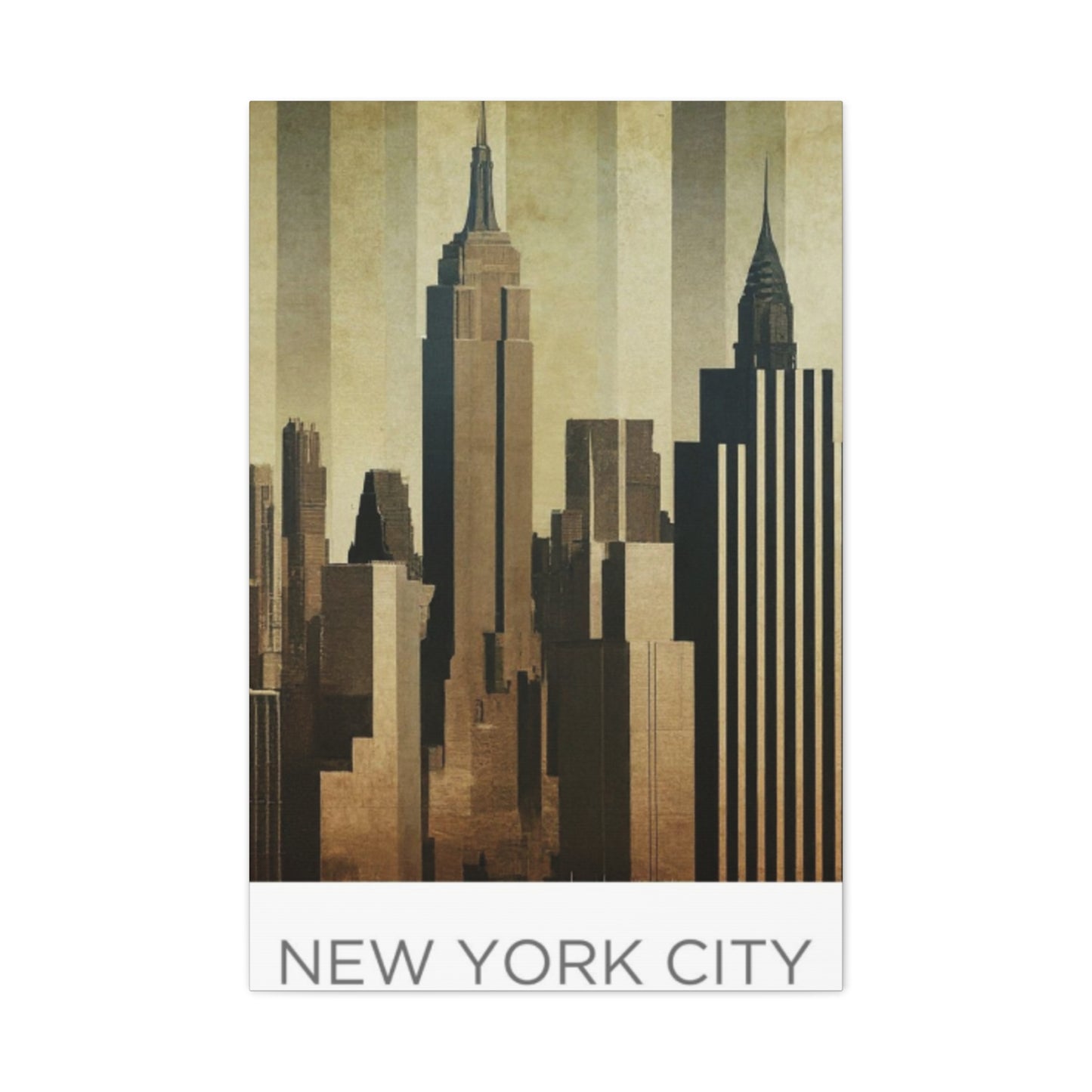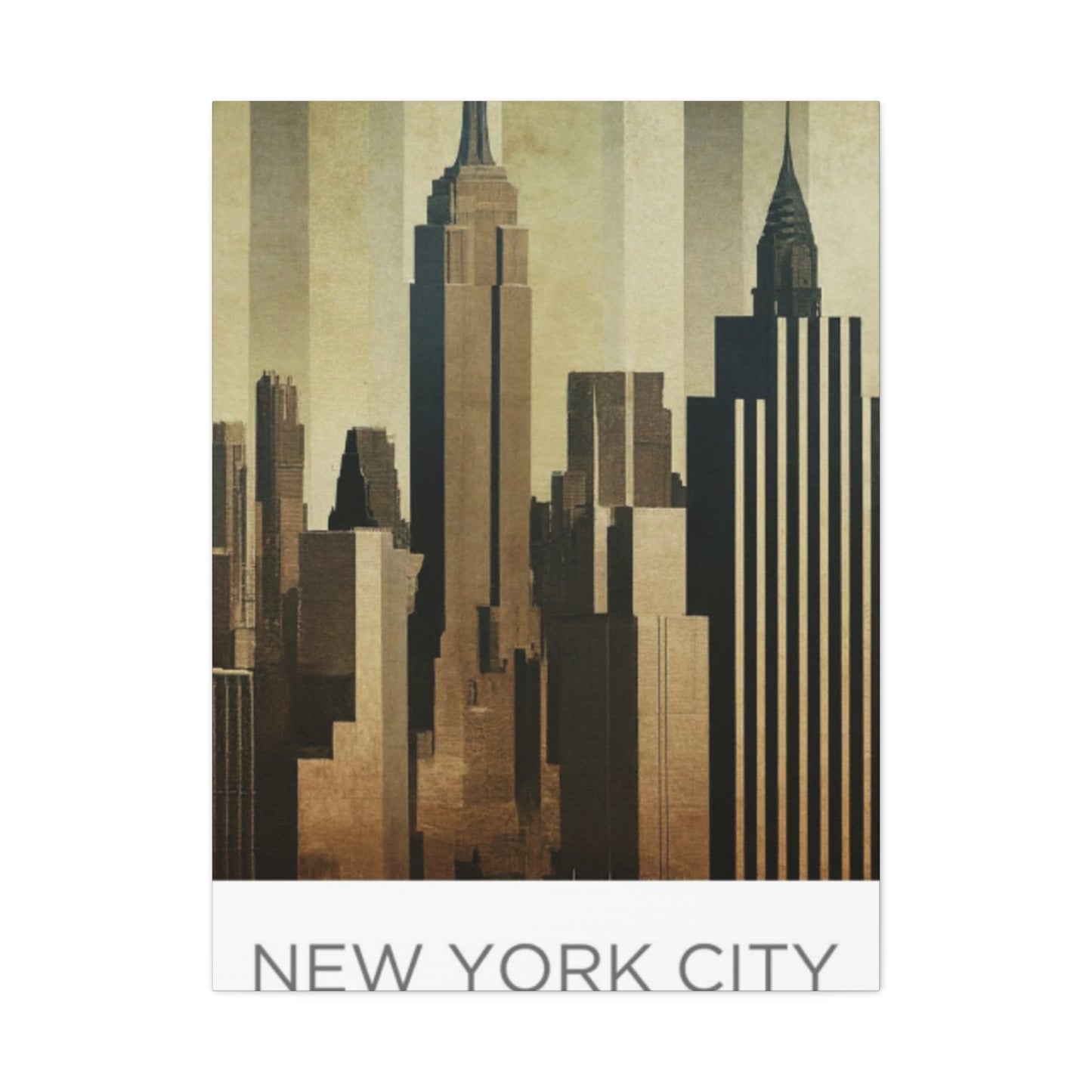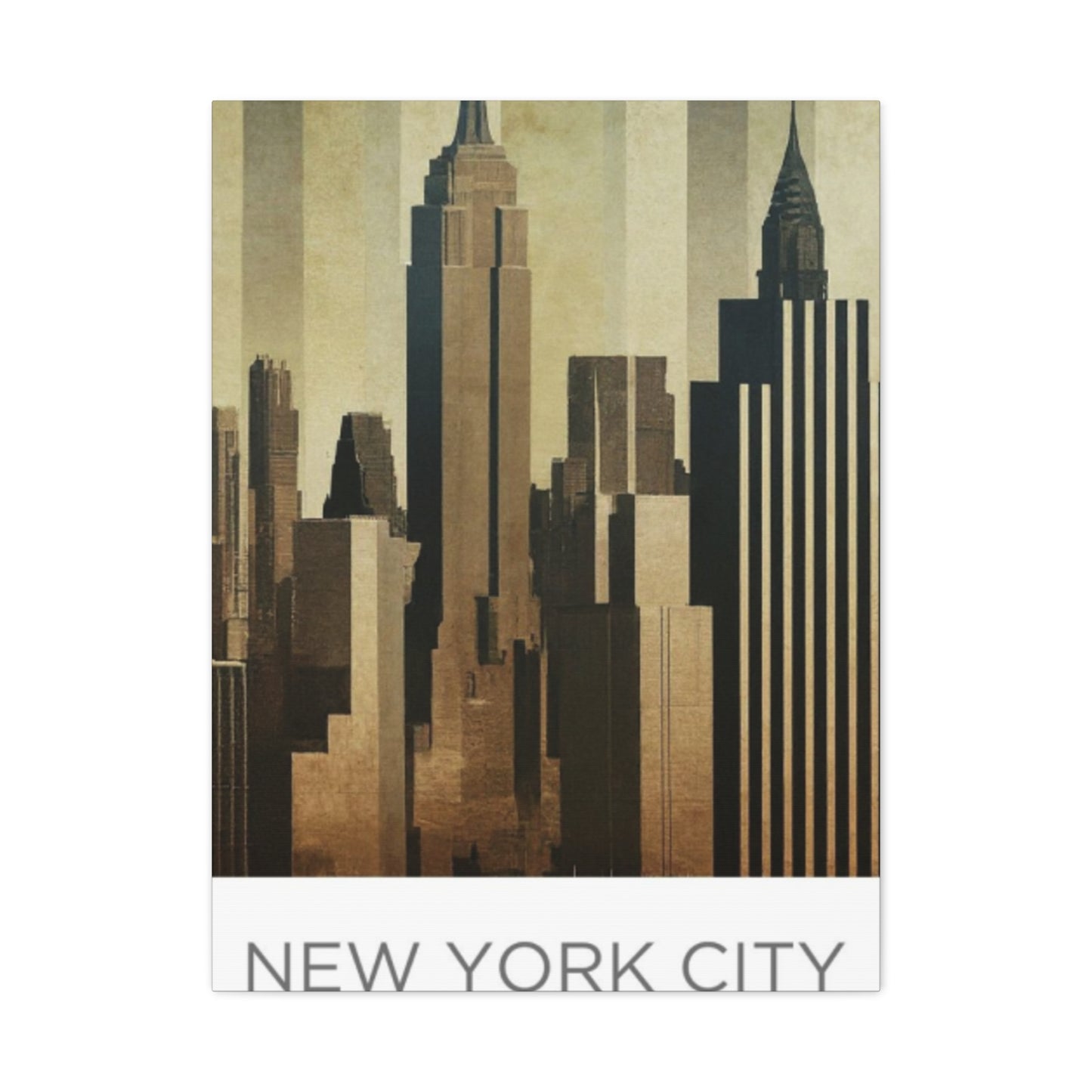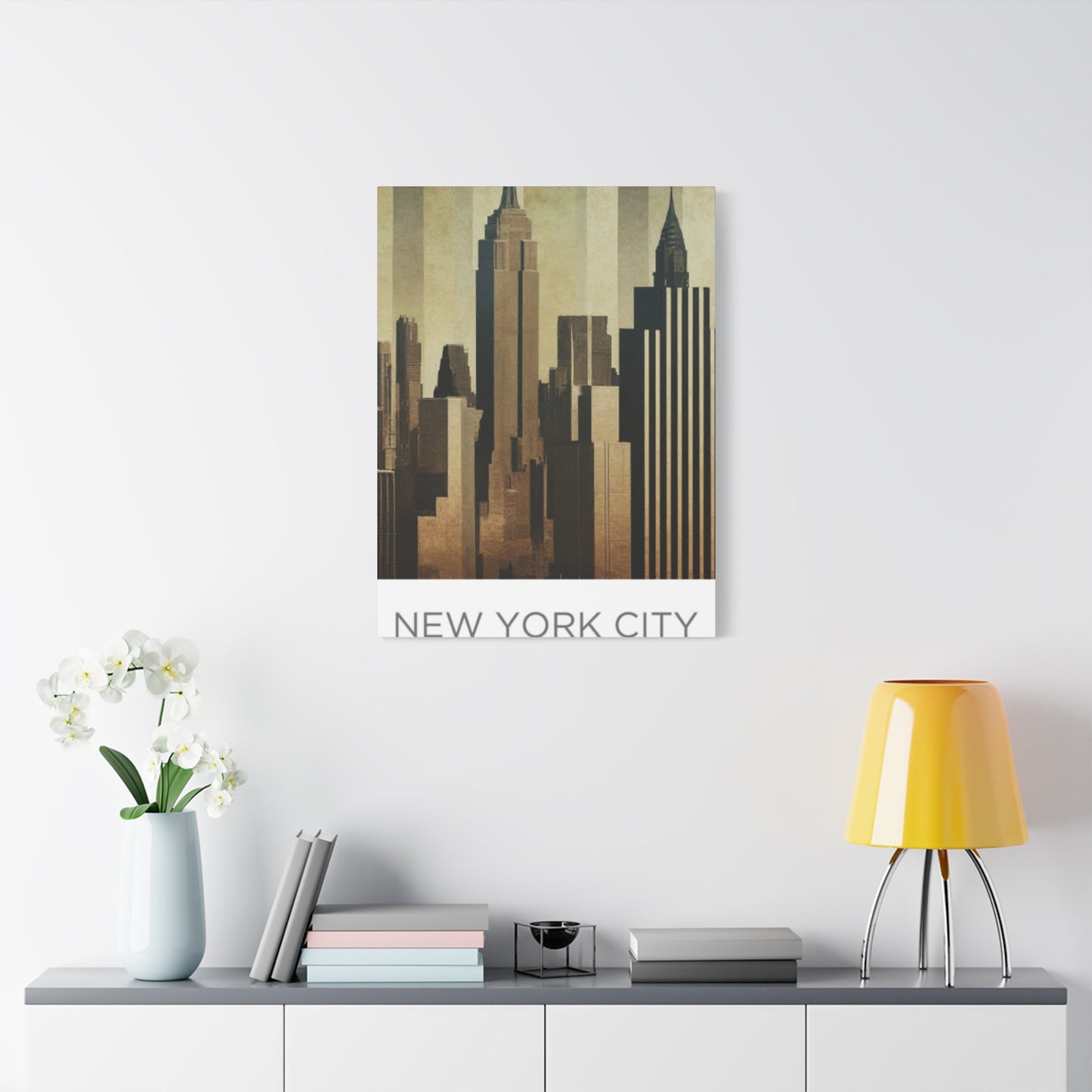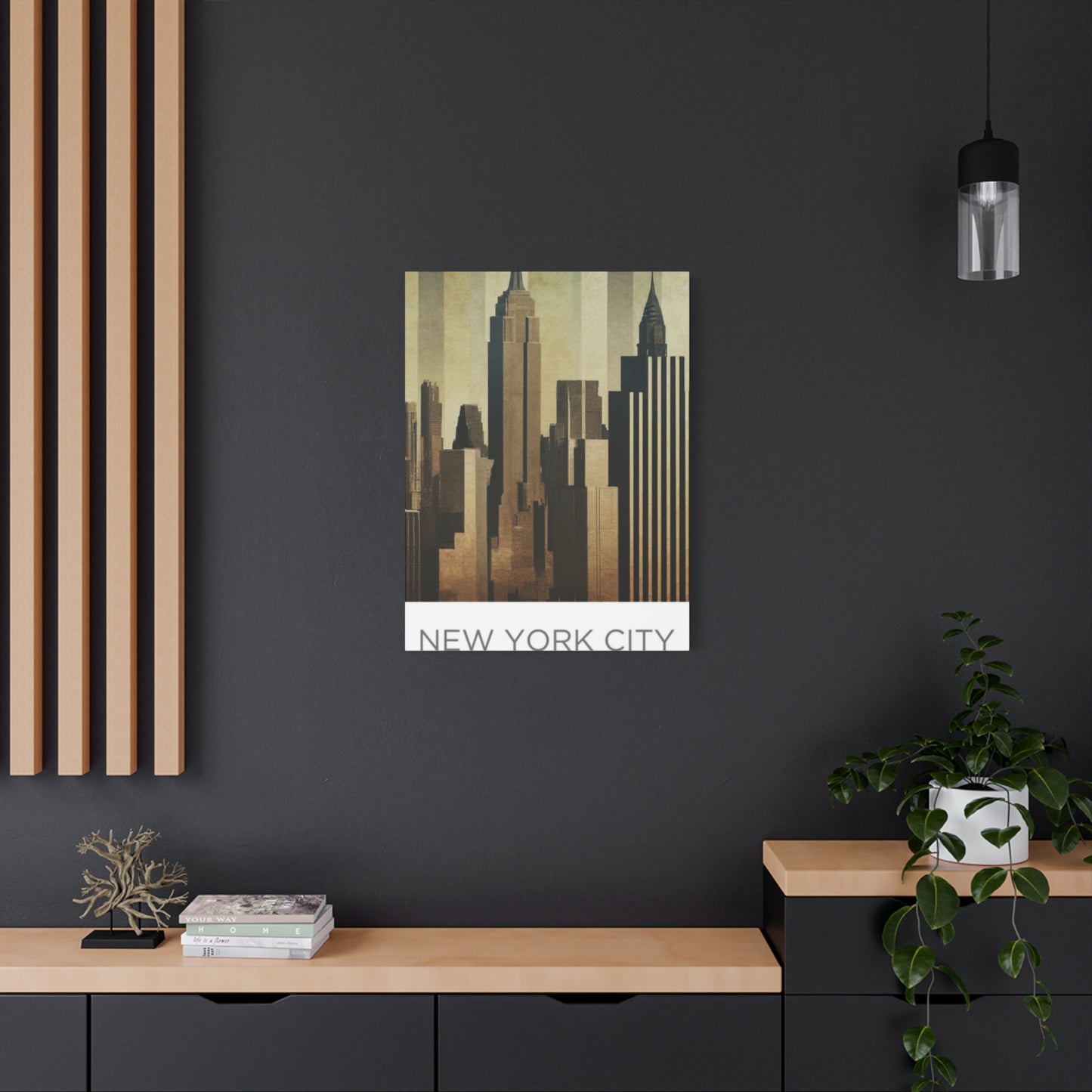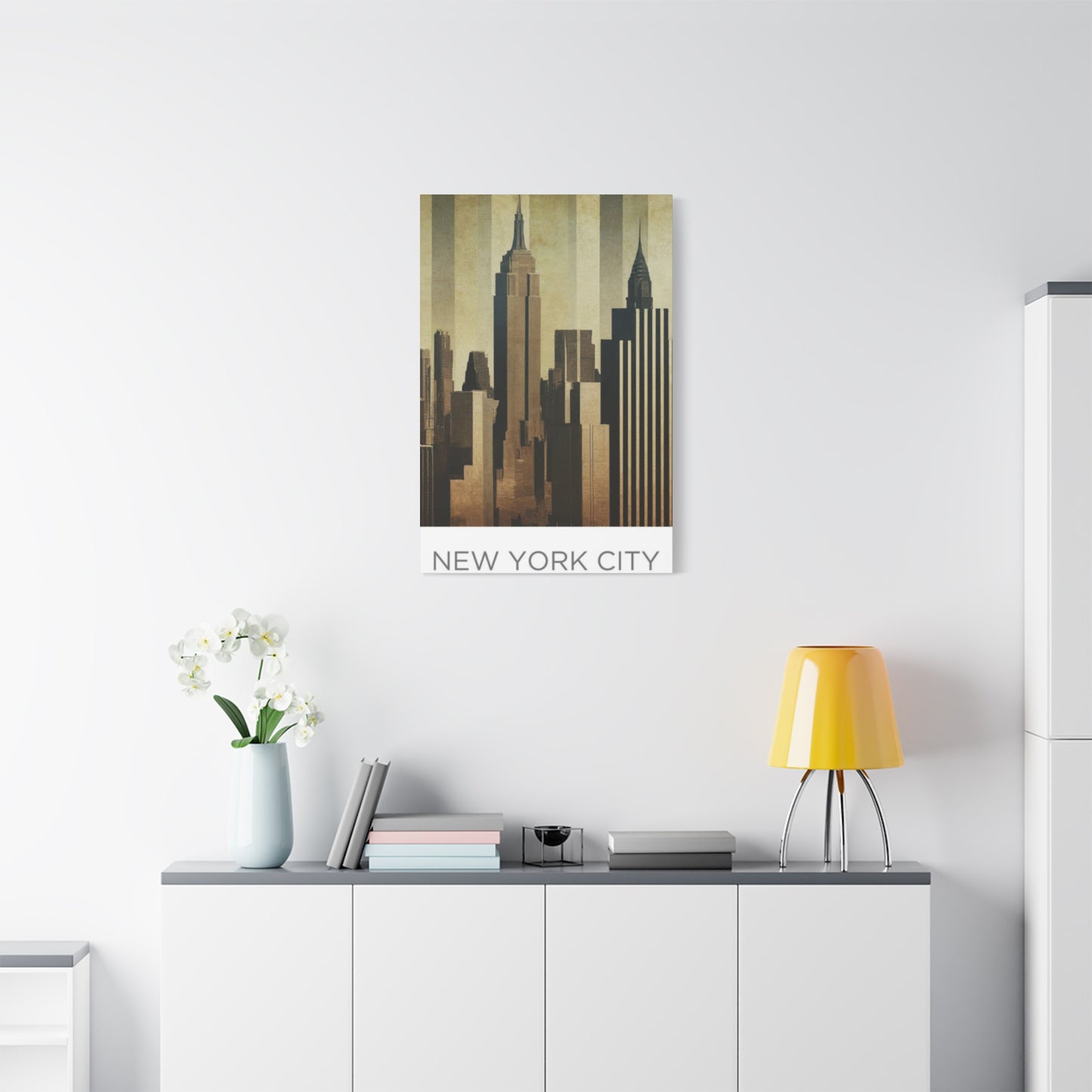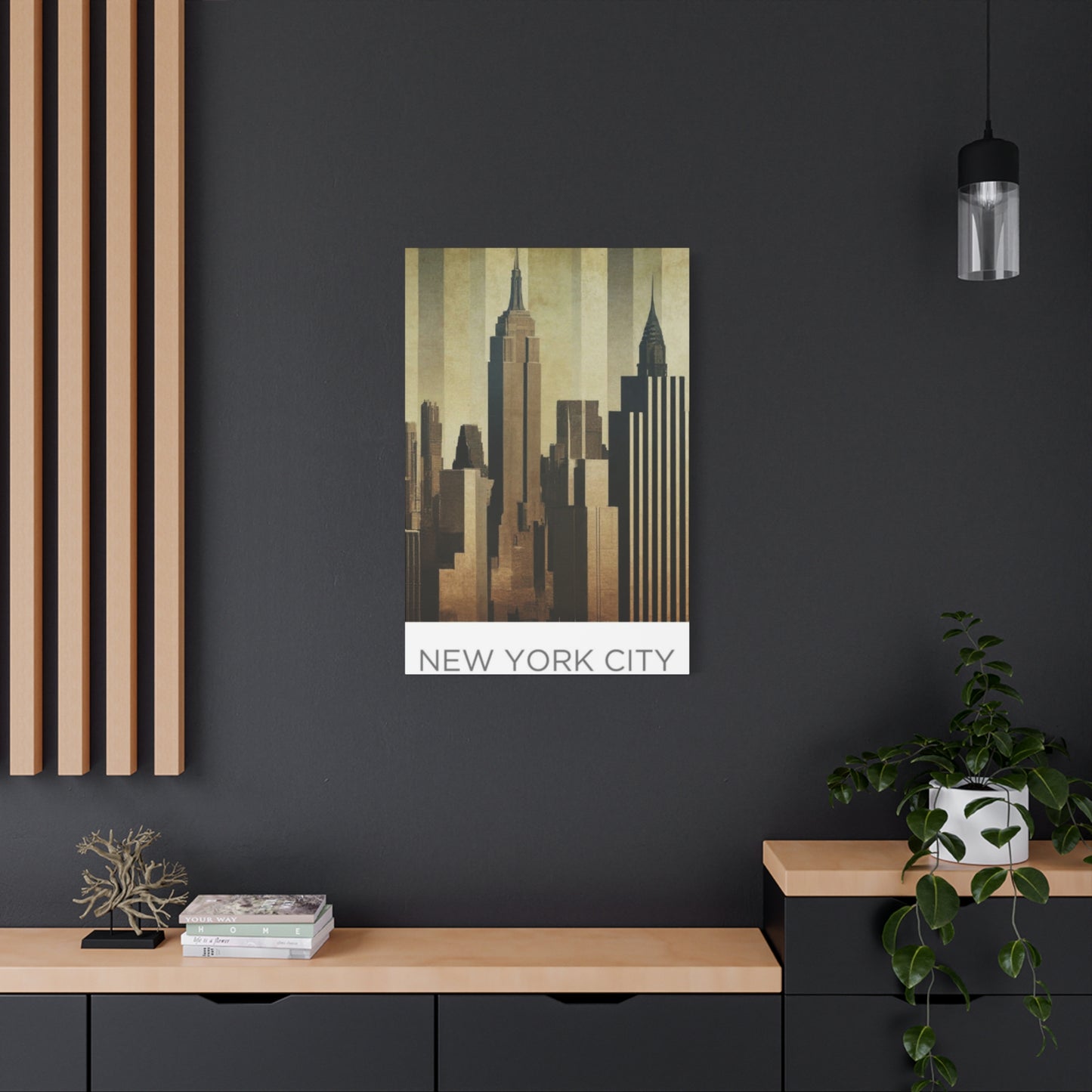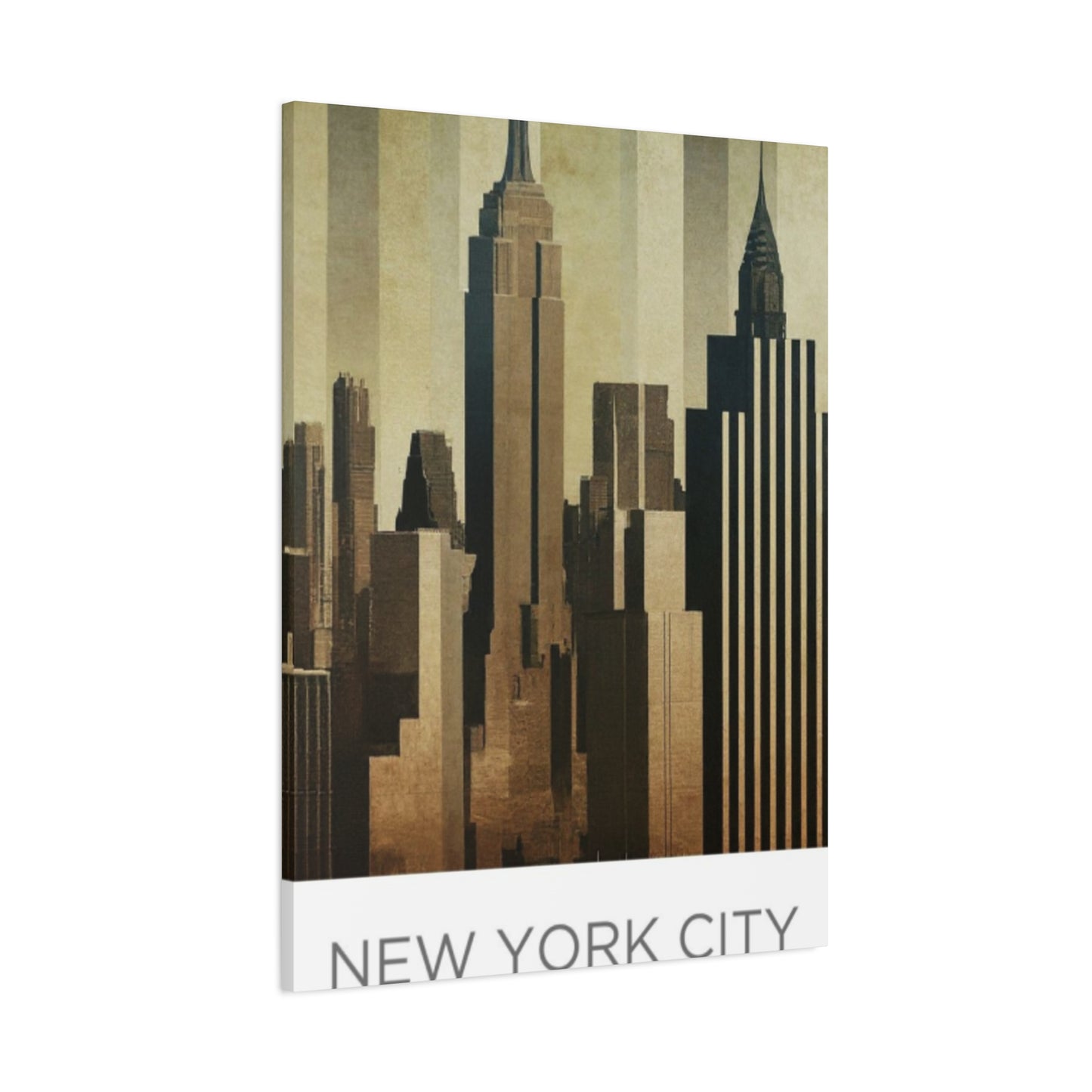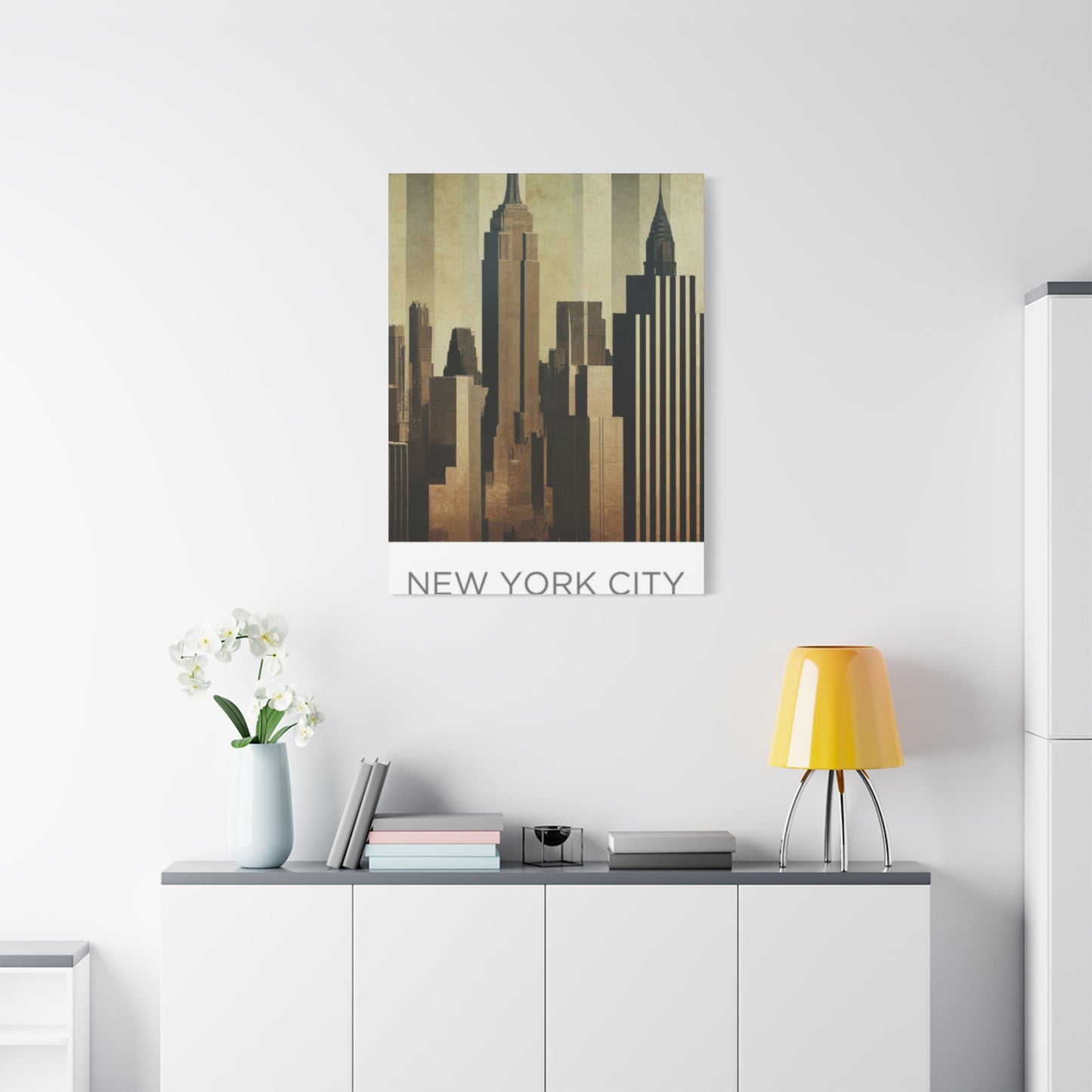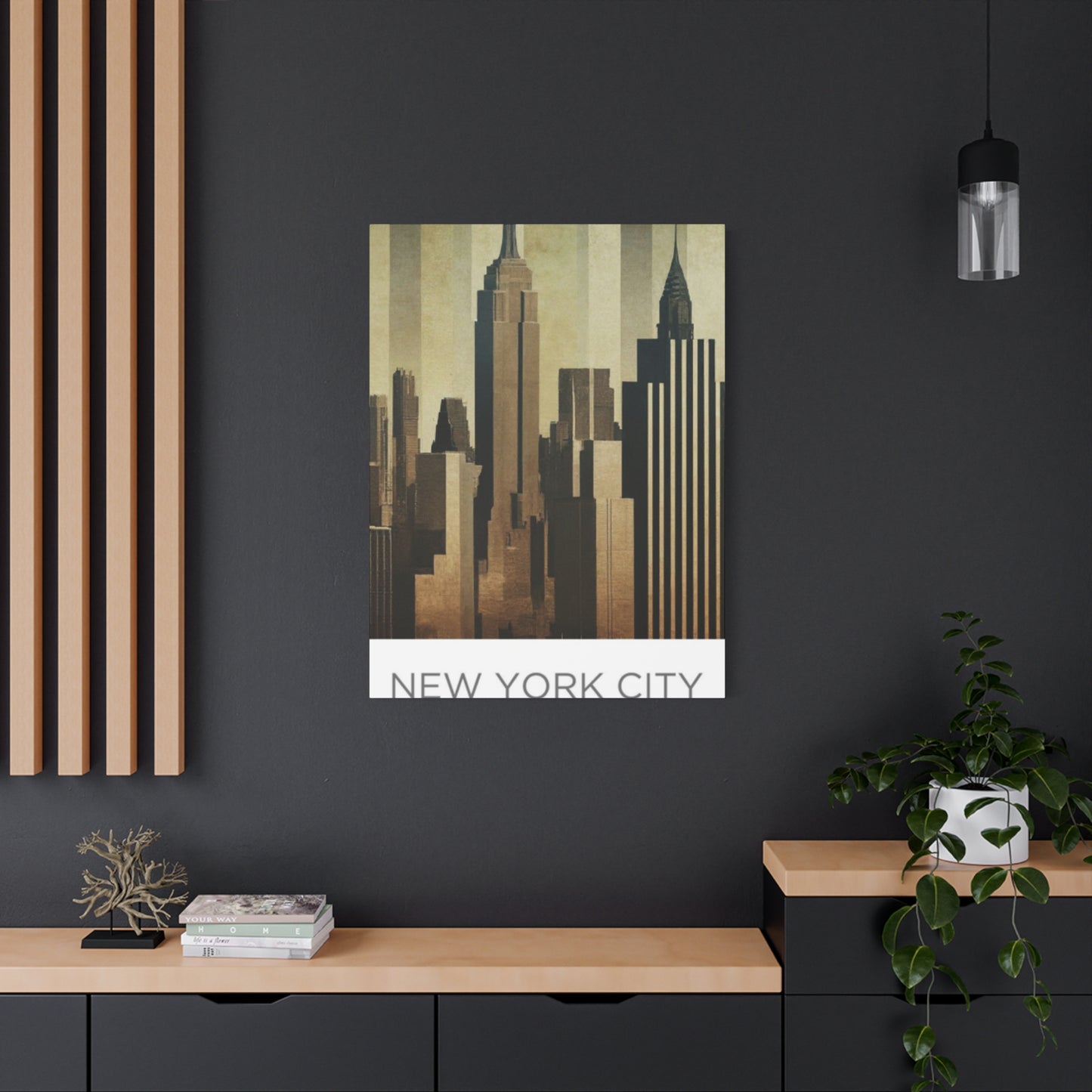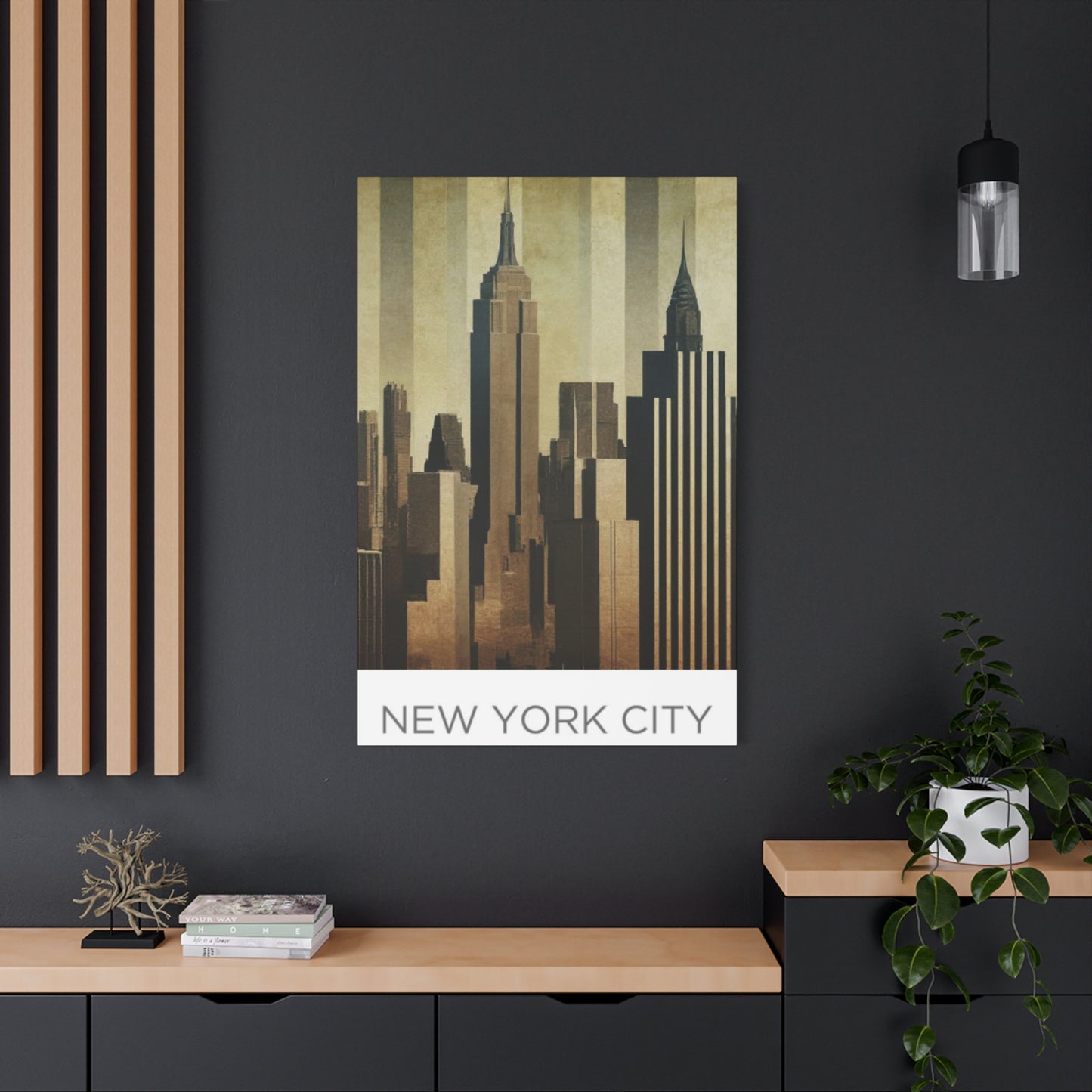Sepia Tone NYC Skyline Wall Art: Bringing Timeless Manhattan Beauty Into Your Living Space
New York City represents one of the most photographed metropolitan areas across the globe, and its iconic skyline has captivated artists, photographers, and interior designers for decades. The architectural magnificence of Manhattan's towering structures creates a visual narrative that speaks to ambition, innovation, and urban sophistication. When captured through sepia tones, these images transform into nostalgic masterpieces that bridge the gap between contemporary design and vintage aesthetics. The warm, earthy hues of sepia photography add depth and character to any space, making them particularly appealing for homes, offices, and commercial establishments seeking to create an atmosphere of refined elegance.
The allure of NYC skyline imagery extends beyond mere decoration; it represents a connection to one of the world's most influential cities. Whether you've lived in New York, visited as a tourist, or simply admire its cultural significance from afar, displaying these images creates an immediate conversation piece. The sepia tone treatment adds an additional layer of artistic interpretation, softening the harsh edges of modern architecture while highlighting the timeless qualities that make New York's skyline instantly recognizable. This photographic style evokes memories of early 20th-century photography, when pioneers of the medium first began documenting the city's vertical growth. By choosing sepia-toned prints, homeowners and decorators tap into this rich photographic heritage while maintaining relevance in contemporary interior design schemes.
Why Sepia Photography Creates Such Powerful Visual Impact
Sepia toning originated in the early days of photography as a chemical process that replaced the metallic silver in prints with a more stable silver sulfide compound. This process not only improved the longevity of photographs but also created the distinctive brown tones that we associate with vintage imagery today. The warm spectrum of colors produced by sepia toning ranges from light cream and tan to deep chocolate brown, creating a cohesive palette that complements virtually any interior design scheme. Unlike stark black and white photography, sepia images possess an inherent warmth that makes them feel more approachable and less clinical in residential settings.
The psychological impact of sepia photography should not be underestimated. These warm tones trigger nostalgic responses in viewers, even when depicting contemporary subjects. This emotional resonance makes sepia-toned NYC skyline prints particularly effective in creating spaces that feel both sophisticated and welcoming. The color palette works harmoniously with natural materials like wood, leather, and stone, making these prints versatile additions to various decorating styles. From industrial lofts to traditional libraries, from modern minimalist apartments to eclectic bohemian spaces, sepia-toned skyline imagery adapts seamlessly. The subdued color range ensures that these prints enhance rather than overwhelm their surroundings, providing visual interest without creating jarring contrasts or competing with other decorative elements in the room.
Choosing the Perfect NYC Skyline Composition for Your Space
Selecting the right skyline composition requires careful consideration of both the space itself and the specific Manhattan views that resonate most strongly with you. Classic perspectives include the downtown financial district with its dense cluster of skyscrapers, midtown Manhattan featuring the Empire State Building and Chrysler Building, or panoramic views that capture the entire island from various vantage points. Each perspective tells a different story about New York City. Downtown views emphasize corporate power and modern commerce, while midtown compositions often highlight the art deco architecture that defines much of New York's golden age of construction. Panoramic perspectives provide a comprehensive view that showcases the city's impressive scale and architectural diversity.
The composition's orientation matters significantly when planning your installation. Horizontal panoramic views work exceptionally well above sofas, beds, or console tables, creating a sweeping vista that draws the eye across the entire width of the wall. Vertical compositions suit narrower wall spaces, hallways, or areas beside doorways where horizontal prints would feel cramped. Some collectors prefer triptychs or multi-panel arrangements that divide the skyline across several canvases, creating a modern gallery effect while maintaining the cohesive imagery of a single scene. These multi-panel displays allow for creative arrangements and can help fill larger wall spaces without requiring a single massive print. Consider the architectural features visible in different skyline views and how they might complement or contrast with your existing decor. A view featuring the Brooklyn Bridge might resonate with someone who appreciates historic engineering, while a composition dominated by contemporary glass towers might appeal to those with more modern sensibilities.
Canvas Print Quality and Its Impact on Final Results
The quality of canvas printing dramatically affects how your sepia-toned NYC skyline artwork will look in your space and how long it will maintain its visual appeal. Professional-grade canvas prints utilize high-resolution digital printing technology that captures subtle gradations in tone and fine architectural details that make skyline photography compelling. The canvas material itself contributes significantly to the overall aesthetic. Premium cotton or poly-cotton blend canvases provide superior color reproduction and durability compared to synthetic alternatives. The texture of canvas adds dimensionality to the image, creating subtle variations in how light reflects off different areas of the print and giving the artwork a more substantial, gallery-worthy appearance.
Archival-quality inks represent another crucial quality factor. Pigment-based inks resist fading far better than dye-based alternatives, ensuring that your sepia tones remain rich and warm for decades rather than gradually fading to muddy browns or losing their distinctive character. UV-resistant coatings provide additional protection against sunlight exposure, which is particularly important for prints displayed near windows or in brightly lit spaces. The printing resolution determines how much detail the final image will display. For large-format skyline prints, you want images printed at no less than 300 dots per inch to ensure that architectural details remain crisp and clear rather than appearing pixelated or blurry when viewed up close. The canvas weight, typically measured in grams per square meter, affects both the durability and the perceived quality of the finished product. Heavier canvases feel more substantial and resist warping or sagging over time, particularly in larger formats.
Stretching and Framing Options for Canvas Skyline Prints
The presentation method you choose for your sepia-toned NYC skyline canvas significantly impacts its visual effect and how it integrates into your decor. Gallery wrap stretching remains the most popular contemporary option, where the image continues around the edges of the wooden stretcher frame, eliminating the need for additional framing. This clean, modern presentation allows the artwork to float on the wall, creating a sophisticated gallery aesthetic. The depth of the stretcher bars affects the overall look; thicker stretcher bars create more dramatic shadows and give the piece greater physical presence on the wall. Standard depths range from three-quarters of an inch to two inches, with deeper options creating more sculptural effects.
Museum wrap stretching offers an alternative where neutral color or a continuation of the edge pixels wraps around the sides rather than the main image, keeping important compositional elements fully visible from the front. This approach works particularly well with skyline images where you want to ensure no buildings or architectural features get wrapped around the edges and become less visible. Traditional framing provides another option, particularly for those seeking a more classic presentation. A simple frame in dark wood, black, or metallic finishes can enhance the vintage quality of sepia-toned imagery while protecting the canvas edges and providing a finished look that works well in traditional interiors. The frame selection should complement rather than compete with the image; ornate frames can overwhelm the subtle beauty of sepia skyline photography, while simple profiles enhance the artwork's inherent elegance. Some collectors prefer floating frames that create a gap between the canvas and the frame, combining the clean aesthetic of gallery wrapping with the defined boundaries of traditional framing.
Strategic Placement of NYC Skyline Wall Art Throughout Your Home
The location where you display your sepia-toned Manhattan skyline artwork significantly influences its impact and how you experience the piece daily. Living rooms offer prime display opportunities, particularly on the main focal wall opposite or above seating arrangements. Positioning skyline art above a sofa creates a natural gathering point for conversation and provides an impressive backdrop for the social heart of your home. The horizontal expanse of skyline panoramas complements the linear nature of sofas and entertainment centers, creating visual harmony through repetition of form. Consider the viewing distance when selecting size; artwork that appears perfectly scaled from across the room might feel overwhelming when viewed from a closer perspective in a smaller space.
Bedroom placement requires different considerations, as these spaces prioritize relaxation and personal comfort. Skyline imagery above the bed creates a dramatic focal point while maintaining the calming qualities essential to sleep spaces. The nostalgic warmth of sepia tones contributes to a soothing atmosphere rather than the energizing effect that bright, colorful artwork might create. Home offices and studies benefit tremendously from NYC skyline art, as the imagery evokes productivity, ambition, and urban sophistication. The presence of architectural achievement can serve as inspiration during work hours, while the artistic quality prevents the space from feeling too corporate or sterile. Hallways and transitional spaces often get overlooked in decorating schemes, but they provide excellent opportunities for vertical skyline compositions or series of smaller prints arranged in a gallery wall format. Dining rooms can accommodate skyline artwork as well, particularly in contemporary or urban-themed spaces where the city imagery enhances the cosmopolitan atmosphere.
Combining Multiple NYC Skyline Prints for Gallery Wall Displays
Creating gallery wall arrangements with multiple sepia-toned NYC skyline prints offers opportunities for dramatic visual impact and creative expression beyond what single prints can achieve. Multi-print installations allow you to tell more comprehensive stories about New York City by showing different perspectives, neighborhoods, or times of day within a cohesive display. The arrangement possibilities are virtually limitless, from symmetrical grid patterns that create order and formality to organic, salon-style groupings that feel more casual and collected over time. When planning a gallery wall, consider creating a physical layout on the floor first, arranging the canvases to experiment with different configurations before committing to hanging them.
Symmetrical arrangements work wonderfully in formal spaces or contemporary interiors where order and balance feel appropriate. A simple three-panel arrangement with identically sized canvases creates a triptych effect that maintains the visual unity of a single image while adding dimensional interest through the gaps between panels. This approach works particularly well with panoramic skyline views, essentially dividing one long composition across three separate canvases. Larger grid arrangements with four, six, or nine panels can fill substantial wall areas while maintaining a sense of organization and intentional design. These grids work best when all panels are identically sized and when spacing between them remains consistent throughout the arrangement. The overall effect resembles a single large image divided into segments, creating a contemporary gallery aesthetic that feels sophisticated and carefully considered.
Asymmetrical gallery walls offer more creative freedom and can incorporate canvases of varying sizes, creating dynamic arrangements with more visual movement and personality. These collections might include a dominant large-format skyline print as a focal point surrounded by smaller supporting images that show architectural details, different neighborhoods, or complementary perspectives. The key to successful asymmetrical arrangements lies in achieving visual balance even without perfect symmetry. This balance can come from distributing visual weight throughout the arrangement, ensuring that one side doesn't feel significantly heavier or more crowded than the other. Color consistency becomes especially important in multi-print displays; using sepia-toned images throughout ensures that the collection feels cohesive despite variations in composition or subject matter. The shared warm brown tones unify disparate images into a coherent collection that reads as an intentional grouping rather than random unrelated prints that happen to share wall space.
Customization Options for Personalized Skyline Canvas Prints
Customization transforms standard NYC skyline canvas prints into truly personal artwork that reflects your individual taste and memories. Many print services now offer modification options that allow you to specify precise sepia toning preferences, controlling whether the final image leans toward warmer golden browns or cooler gray-browns. This color control ensures the print perfectly complements your existing decor color palette rather than requiring you to adjust your space to accommodate the artwork. Some services also allow adjustments to contrast levels, enabling you to request higher contrast for more dramatic impact or softer contrast for subtler, more understated presentations.
Adding text to your canvas print creates personalized artwork with special meaning. Consider incorporating significant dates like wedding days, first visits to New York, or other memorable occasions associated with the city. Favorite quotes about New York or meaningful phrases can also overlay skyline images, creating inspirational pieces that combine visual beauty with words that resonate personally. The text styling should complement the vintage aesthetic of sepia photography; consider classic serif fonts that echo the era suggested by the sepia tones rather than ultra-modern sans-serif options that might create jarring stylistic conflicts. Text placement requires careful consideration to avoid obscuring important architectural elements while ensuring legibility against the varied tones of the skyline image.
For truly unique pieces, commission custom photography that captures specific NYC locations or perspectives meaningful to you personally. If you lived in a particular Manhattan neighborhood, worked in a specific building, or have favorite spots throughout the city, having these locations professionally photographed and processed in sepia tones creates one-of-a-kind artwork impossible to find through standard print catalogs. The investment for custom photography exceeds standard print costs, but the personal significance and uniqueness often justify the premium for those celebrating important connections to New York. Another customization approach involves creating composite images that combine elements from multiple photographs, perhaps incorporating both daytime and nighttime lighting, different weather conditions, or landmarks from various neighborhoods into a single cohesive composition that represents your comprehensive experience of New York City.
Architectural Styles Represented in Manhattan's Skyline
New York City's skyline functions as a three-dimensional architectural history textbook, displaying evolution in building styles from the late 19th century through contemporary construction. Understanding these architectural movements enhances appreciation for skyline photography and helps identify specific elements that make certain compositions particularly appealing. Beaux-Arts architecture appears in early skyscrapers built during the late 19th and early 20th centuries, characterized by elaborate ornamentation, classical details, and emphasis on symmetry and formal design principles. Buildings like the Woolworth Building exemplify this approach, featuring Gothic revival details and elaborate terra cotta ornamentation that rewards close examination in detailed skyline photographs.
Art Deco architecture emerged in the 1920s and 1930s, producing some of Manhattan's most beloved and recognizable skyscrapers. This style emphasized vertical lines, geometric patterns, and stylized ornamentation that suggested modernity while maintaining decorative richness. The Chrysler Building and Empire State Building represent the pinnacle of Art Deco skyscraper design, with their distinctive crowns and setback profiles creating memorable silhouettes that dominate midtown skyline views. The stepped-back form mandated by zoning regulations designed to preserve light and air at street level became an Art Deco signature, creating the ziggurat-like profiles that distinguish pre-war skyscrapers from later buildings. When captured in sepia tones, Art Deco architecture particularly shines, as the warm brown tones complement the era these buildings represent and highlight the dramatic vertical lines and geometric ornamentation.
International Style modernism arrived in the 1950s and dominated corporate architecture through the end of the century, introducing the glass and steel boxes that gave Midtown Manhattan much of its current character. This aesthetic prioritized function over decoration, emphasized clean lines and minimal ornamentation, and used modern materials like curtain wall glass to create entirely new relationships between interior and exterior spaces. Buildings like the Seagram Building, Lever House, and the former World Trade Center towers exemplify this approach. While sometimes criticized as austere or impersonal, these modernist towers create interesting contrasts in skyline photography when juxtaposed with earlier decorated styles, and their simple geometric forms translate effectively into graphic compositions that work well in sepia tones.
Contemporary architecture represented in Manhattan's newest towers embraces sculptural forms and distinctive silhouettes that help individual buildings stand out in increasingly crowded skylines. Advances in engineering, materials, and computer-aided design enable shapes impossible in earlier eras, from twisting towers to buildings with complex faceted surfaces. One World Trade Center, with its chamfered edges forming an elongated square footprint that rotates as the building rises, demonstrates how contemporary design creates memorable forms through overall shape rather than applied ornamentation. When these contemporary towers appear in sepia-toned skyline photography, the contrast between their ultra-modern forms and the vintage photographic treatment creates interesting tension between past and present that adds conceptual depth to the imagery.
Creating Thematic Interior Spaces with NYC Skyline Art
Sepia-toned NYC skyline canvas prints serve as anchors for creating thematic interior designs that transport residents and visitors to specific times, places, or atmospheres. An industrial loft aesthetic pairs naturally with Manhattan skyline imagery, as both celebrate urban environments, architectural elements, and the conversion of commercial spaces to residential use. Combine skyline prints with exposed brick walls, visible ductwork, concrete floors, metal furnishings, and warm Edison bulb lighting to create spaces that feel like Manhattan lofts regardless of actual location. The sepia tones bridge the gap between rough industrial elements and more refined decorative items, preventing the space from feeling too harsh or unfinished.
Jazz age or prohibition era themes work wonderfully with sepia skyline imagery, particularly views emphasizing 1920s and 1930s Art Deco architecture. Build the theme through furniture selections including tufted leather seating, dark wood with brass details, and vintage-inspired bar carts. Add period-appropriate decorative elements like art deco mirrors, geometric patterns in textiles, and amber or colored glass accessories. The sepia skyline prints reinforce the temporal theme while providing impressive focal points that establish the era being referenced. Lighting becomes particularly important in these themed spaces; choose fixtures with vintage character including Edison bulbs, art deco inspired designs, or reproduction period pieces that complement the 1920s and 1930s feeling suggested by the artwork.
Mid-century modern themes present another option where NYC skyline art contributes to cohesive period design. Focus on skyline views emphasizing the clean lines of International Style architecture built during the 1950s through 1970s. Pair these images with iconic mid-century furniture from designers like Eames, Saarinen, or Wegner, geometric patterns in textiles and rugs, and warm wood tones in furniture and architectural elements. The sepia treatment of skyline photographs adds vintage character that keeps the space from feeling like a design museum while maintaining the clean, uncluttered aesthetic central to mid-century design philosophy. For more eclectic or bohemian spaces, NYC skyline art provides urban edge that grounds collections of varied furniture styles, global textiles, and collected objects that might otherwise lack cohesion. The recognizable imagery serves as a familiar anchor point around which more adventurous design choices can orbit without the space feeling chaotic or confused.
The Role of Nostalgia in Contemporary Interior Design
Contemporary interior design increasingly embraces nostalgic elements as counterbalance to the rapid pace of technological change and cultural evolution in modern life. Sepia-toned NYC skyline prints perfectly embody this nostalgic trend, offering visual connections to earlier eras while depicting subjects that remain relevant and recognizable today. This dual nature allows spaces to feel simultaneously current and historically grounded, avoiding the disconnected feeling that aggressively modern design can sometimes create. The psychology of nostalgia reveals that these positive feelings about the past contribute to present wellbeing, providing comfort, reinforcing identity, and creating sense of continuity between past and present that helps people feel more secure in rapidly changing environments.
Nostalgia in design doesn't require literal historical accuracy or period-perfect reproduction; instead, it evokes feelings and atmospheres associated with earlier times while accommodating contemporary needs and lifestyles. Sepia-toned skyline imagery captures this balance perfectly by using vintage photographic techniques on subjects that include both historical and contemporary architecture. This approach allows you to celebrate New York's architectural heritage while acknowledging its continuing evolution. The warm emotional responses triggered by nostalgic design elements including sepia photography create environments where people feel more comfortable, relaxed, and connected to the spaces they inhabit. These positive associations improve quality of life in measurable ways, from reduced stress levels to increased likelihood of entertaining guests and engaging in creative activities at home.
The current renaissance of vintage aesthetics across fashion, graphic design, and interior decoration reflects broader cultural phenomena where people seek anchors of familiarity amidst constant change. Instagram filters mimicking vintage photography, the resurgence of vinyl records, popularity of vintage and antique furnishings, and preference for craft and handmade items all demonstrate this nostalgia-driven trend. Sepia-toned NYC skyline prints align perfectly with these broader movements, offering decoration that feels both personally meaningful and culturally relevant. The specific nostalgia evoked by New York imagery carries particular resonance, as the city represents pivotal moments in American cultural history from the Jazz Age through the mid-century modern era, all periods currently experiencing renewed interest and appreciation in popular culture.
Pairing NYC Skyline Art with Complementary Decor Elements
Creating cohesive interior spaces requires thoughtful coordination between skyline artwork and surrounding decorative elements, ensuring that all components work together harmoniously rather than competing for attention. Furniture selections significantly impact how effectively skyline prints integrate into spaces. For contemporary interiors featuring sepia skyline imagery, choose furniture with clean lines and simple silhouettes that don't compete with the detailed architectural content of the artwork. Mid-century modern furniture works particularly well, as its era corresponds roughly with the time period suggested by sepia toning, creating temporal cohesion throughout the space. Leather upholstery in cognac, tan, or chocolate brown shades echoes the warm tones in sepia photography, building visual connections throughout the room.
Textile selections including throw pillows, blankets, curtains, and area rugs provide opportunities to reinforce color relationships established by sepia skyline art. Look for fabrics in complementary warm neutrals ranging from cream through tan and taupe to chocolate brown, creating a cohesive palette where the artwork feels integrated rather than isolated. Patterns can work effectively provided they don't overwhelm or clash with the detailed imagery in skyline photography. Geometric patterns, subtle stripes, or organic textures tend to complement architectural subjects better than competing pictorial patterns. Metallic accents in brass, bronze, copper, or warm-toned metals strengthen connections with sepia imagery while adding sophistication and visual interest. These metallics appear in lighting fixtures, decorative objects, picture frames, furniture hardware, and accessories, creating sparkle and reflection that energizes neutral color palettes.
Lighting fixtures deserve special consideration as both functional necessities and decorative elements that significantly impact overall aesthetic. Industrial-style fixtures with exposed bulbs and metal finishes complement NYC skyline art effectively, reinforcing urban themes and providing visual consistency. Vintage-inspired fixtures suggesting 1920s through 1950s design work beautifully with sepia imagery, strengthening the temporal suggestions inherent in the photographic treatment. Additional artwork and decorative objects should complement rather than compete with skyline prints. Consider architectural drawings, vintage maps of New York City, black and white photography of urban subjects, or abstract art in complementary color palettes as supporting pieces that enhance rather than distract from your focal skyline artwork. Books displayed on coffee tables, shelving, or in bookcases provide another opportunity to reinforce themes; architecture monographs, New York history books, photography collections, and urban planning texts all support the aesthetic established by skyline artwork while adding intellectual dimension to the space.
Regional Differences in NYC Skyline Photography Appeal
The appeal of New York City skyline artwork varies geographically, with different regions showing distinct preferences and relationships to this imagery. In the New York metropolitan area itself, skyline prints serve multiple functions from nostalgic remembrances of the city as it existed during specific eras to celebrations of current architecture for residents proud of their home city. New Yorkers often select skyline views featuring their specific neighborhoods or areas where they work, creating personal connections to the imagery beyond general appreciation for Manhattan's architectural beauty. Former New York residents living elsewhere frequently display skyline art as connection to their past, keeping a piece of the city with them wherever they've relocated and maintaining identity as New Yorkers even after geographic circumstances change.
In other major American cities, NYC skyline art often represents aspirations and connections to the quintessential American metropolis. Professionals in finance, law, media, and other industries with significant New York presences display these images as affirmations of their connection to broader industry networks and sophisticated urban culture. In smaller towns and rural areas, Manhattan skyline imagery can represent dreams of urban life, connections to broader American culture, or simply appreciation for impressive architecture and urban environments that contrast dramatically with local surroundings. Internationally, New York skyline imagery carries strong associations with American culture, economic power, and entertainment industry representations that have made these views familiar worldwide. Foreign visitors often acquire these prints as meaningful souvenirs, while people who have never visited New York display the imagery as connection to American culture or aspiration to eventually experience the city themselves.
Generational differences also affect the appeal and interpretation of NYC skyline art. Older generations who remember New York during mid-century often feel strong nostalgic attachments to sepia-toned imagery that recalls their youth or prime working years. Baby boomers and Generation X viewers who grew up seeing New York in films, television, and news coverage during the latter 20th century connect these images to formative cultural experiences and the city's representation in media they consumed. Millennials and Generation Z approach NYC skyline imagery with different frameworks, often appreciating the vintage aesthetic on purely visual grounds rather than through direct memory or nostalgia for eras before they were born. For these younger generations, sepia-toned skyline photography represents a design choice and aesthetic statement more than historical documentation or personal memory, though the imagery remains powerful and appealing across all age groups.
The Intersection of Photography and Digital Art in Canvas Prints
Modern NYC skyline canvas prints exist at the intersection of photography and digital art, combining traditional photographic capture with digital manipulation and processing that transforms original images into artistic creations distinct from pure documentary photography. This hybrid nature raises interesting questions about authenticity and artistic value that inform how we understand and appreciate these works. Traditional photography purists sometimes critique digital manipulation as undermining photographic authenticity, arguing that the medium's power derives from capturing reality as it exists rather than creating idealized or altered versions. However, this perspective overlooks photography's long history of darkroom manipulation, selective processing, and artistic choices that have always separated artistic photography from mere documentation.
Sepia toning itself represents an artistic choice and manipulation whether achieved through traditional chemical processes or modern digital techniques. The decision to convert color imagery to monochrome, to select specific warm brown tones, to adjust contrast and local exposure across different areas of the image, all constitute artistic interventions that transform the scene as it existed into an artistic representation of that scene. Digital tools simply provide more precise control over these manipulations than traditional darkroom techniques allowed, enabling artists to achieve exactly the effects they envision rather than approximating them through less controllable chemical processes. The democratization of these tools means more people can create and offer sophisticated photographic art without requiring expensive darkroom facilities or years mastering analog techniques, though artistic vision and technical skill remain essential for producing truly exceptional work.
Contemporary canvas printing technology completes this intersection of photography and digital art by transforming digital files into physical objects that occupy space and can be experienced in ways that screen-based images cannot. The texture of canvas, the physical dimensionality of stretched prints, the way light plays across textured surfaces, all contribute sensory elements beyond what purely digital viewing provides. This physicality matters significantly in how we experience and value artwork; despite unlimited access to digital images, people continue investing in physical prints because the tangible object provides different and more satisfying aesthetic experiences than viewing the same image on screens. The canvas print represents the culmination of a process beginning with photographic capture, continuing through digital artistry in processing and enhancement, and concluding with physical production that transforms ephemeral pixels into lasting objects with presence and permanence.
Sustainable and Eco-Friendly Canvas Print Options
Environmental consciousness increasingly influences purchasing decisions across all product categories, and canvas prints are no exception. Consumers concerned about environmental impact can find eco-friendly options that minimize harm while still delivering exceptional aesthetic results. Sustainable canvas production begins with material selection; organic cotton canvas grown without synthetic pesticides or fertilizers offers significantly reduced environmental impact compared to conventional cotton, one of agriculture's most chemical-intensive crops. Bamboo canvas represents another sustainable alternative, as bamboo grows rapidly without requiring replanting, needs no pesticides, and produces usable material far faster than cotton cultivation. Recycled polyester canvas transforms post-consumer plastic waste into usable substrate for printing, removing material from waste streams while creating durable canvas products.
Eco-friendly ink formulations have evolved significantly, with water-based and latex inks offering alternatives to solvent-based systems that release volatile organic compounds during printing and drying. These environmentally responsible inks achieve color reproduction and longevity comparable to traditional options while eliminating or dramatically reducing air pollution and chemical exposure for workers. The printing facilities themselves can operate more sustainably through renewable energy use, efficient equipment that minimizes electricity consumption, and waste reduction practices including recycling ink cartridges and canvas scraps. Some printing companies pursue carbon neutral operations, calculating their carbon footprint and purchasing offsets to neutralize environmental impact, though the effectiveness and sincerity of carbon offset programs deserves scrutiny.
Packaging and shipping practices contribute significantly to canvas prints' environmental footprint. Minimal packaging using recycled and recyclable materials reduces waste compared to excessive packaging that includes non-recyclable plastics and foam. Some companies now use biodegradable packing materials including cornstarch-based packing peanuts and mushroom-based cushioning materials that can be composted after use. Consolidated shipping where multiple items ship together in single packages reduces transportation-related emissions compared to separate shipments for each item. For environmentally conscious consumers, researching companies' sustainability practices and certifications helps identify options that align with personal values. Third-party certifications including Forest Stewardship Council approval for wood stretcher bars, Global Organic Textile Standard certification for organic canvas, and various environmental management system certifications provide independent verification of environmental claims.
Incorporating NYC Skyline Art in Unexpected Spaces
While living rooms and offices represent traditional locations for displaying skyline artwork, considering less conventional spaces opens creative possibilities. Bathrooms often get overlooked as artwork display locations, but they provide daily viewing opportunities during morning and evening routines. Sepia-toned NYC skyline prints work particularly well in bathrooms because the warm tones complement typical bathroom materials including natural stone, wood vanities, and bronze or brass fixtures. The nostalgic quality creates spa-like atmospheres that enhance relaxation during baths or morning grooming routines. Ensure bathroom artwork includes appropriate moisture protection, though modern canvas prints with protective coatings generally tolerate bathroom humidity provided adequate ventilation prevents excessive moisture buildup.
Home gyms and workout spaces benefit from motivational imagery, and NYC skyline prints featuring impressive human achievement can provide exactly this inspiration during challenging workouts. The upward thrust of skyscrapers creates visual energy that complements fitness goals and physical exertion. Mount artwork where it's visible during workouts but protected from direct contact with equipment or excessive moisture from perspiration. Walk-in closets and dressing areas evolve into more luxurious, personalized spaces with artwork that reflects your style and interests. NYC skyline imagery works particularly well in these spaces if fashion represents an interest, given New York's status as American fashion capital. The sophisticated urban aesthetic complements wardrobes while making the functional space of a closet feel more like a boutique or personal styling suite.
Staircases and landings provide vertical wall space perfect for showcasing skyline imagery as you move between floors. The transitional nature of these spaces parallels the constant movement and change within cities, creating conceptual harmony between subject and location. Libraries or reading nooks gain atmosphere from skyline imagery suggesting the cultural and intellectual vitality of urban environments. The nostalgic sepia tones create cozy, contemplative moods perfect for reading while the architectural subject matter complements the intellectual activity of engaging with books. Mudrooms and entryways make surprisingly effective locations for impressive skyline artwork that greets you upon arriving home and bids farewell as you leave, subtly connecting your home to the broader urban world beyond its walls.
Professional Interior Design Principles for Hanging Wall Art
Successfully hanging canvas prints requires attention to specific principles that professional designers follow to achieve polished, intentional results. Height matters tremendously; artwork hung too high or too low dramatically impacts how effectively it integrates into the space. The standard guideline positions artwork so that the center point falls approximately 57 to 60 inches from the floor, corresponding to average human eye height. This positioning ensures comfortable viewing without craning necks upward or bending down. When hanging artwork above furniture, maintain 6 to 12 inches between the furniture top and the artwork bottom, creating visual connection between the pieces while preventing the artwork from appearing to float awkwardly high on the wall.
Spacing becomes critical in multi-piece arrangements. Maintain consistent gaps between canvases in gallery wall displays, typically 2 to 4 inches depending on overall arrangement size and personal preference. Smaller gaps create unified collections that read almost as single pieces, while larger gaps emphasize individual elements within the grouping. Proportion requires careful consideration; artwork should relate appropriately to both the wall space and the furniture below it. As previously mentioned, pieces above sofas or beds should span roughly two-thirds to three-quarters of the furniture width to achieve visual balance. Lighting dramatically affects how artwork appears and should be planned before hanging pieces. Account for existing light sources and their impact on the artwork, and add dedicated picture lighting or adjust ambient lighting if necessary to showcase your skyline prints effectively.
Tools and hardware selection ensures secure mounting that won't damage walls or allow artwork to fall. For canvas prints, wire hangers attached to stretcher bars provide reliable hanging solutions, distributing weight across multiple points rather than stressing single points. D-rings offer alternatives for heavier pieces or when you want to minimize wire visibility. Wall anchors appropriate to your wall type ensure secure mounting; drywall anchors for standard walls, masonry anchors for brick or concrete, and hollow wall anchors for plaster walls. Always use hardware rated to support more weight than your artwork actually weighs, providing safety margins against failures. Level both individual pieces and entire arrangements carefully; even slightly crooked artwork undermines otherwise sophisticated spaces, drawing attention to installation errors rather than artistic content.
The Influence of Film and Television on NYC Skyline Imagery Popularity
New York City's prominence in film and television dramatically influences how people relate to skyline imagery and partly explains the enduring appeal of these prints. Countless movies have opened with sweeping skyline establishing shots that immediately communicate location and set expectations for urban stories to follow. From romantic comedies to crime dramas, superhero spectacles to intimate character studies, filmmakers have consistently used Manhattan's distinctive silhouette to ground their narratives in specific place and cultural context. This repeated exposure means most people possess familiarity with New York's skyline even if they've never visited, creating comfortable recognition that makes skyline artwork immediately accessible and emotionally resonant.
Television series set in New York have furthered this familiarity, bringing the city into living rooms weekly for decades. Shows ranging from sitcoms to prestige dramas have featured NYC skylines in opening credits, establishing shots, and character moments, unconsciously training viewers to associate these views with entertainment, emotional engagement, and compelling storytelling. The aspirational lifestyles portrayed in many New York-set television shows add glamorous associations to skyline imagery; even modest apartments in television Manhattan often offer spectacular skyline views that suggest success and sophisticated urban living far beyond what actual New York apartments typically provide.
The specific buildings that become prominent in popular culture through film and television often experience increased recognition and appreciation in skyline photography. The Empire State Building gained iconic status partly through its appearances in King Kong, Sleepless in Seattle, and countless other films that established it as symbol of New York and romance itself. The Chrysler Building features prominently in numerous films appreciating its art deco beauty, cementing its position as perhaps the most beloved element of Manhattan's architectural heritage. More recent additions to the skyline including One World Trade Center carry emotional weight from their appearance in documentaries and news coverage, adding layers of meaning beyond pure architectural appreciation. When you display NYC skyline canvas prints, you're not just showing buildings but invoking all these accumulated associations from decades of media representation, which enriches the imagery with collective cultural memory and personal connections to stories experienced through screens.
Economic Factors Affecting the Canvas Print Market
Understanding market dynamics helps consumers navigate purchasing decisions and anticipate pricing trends. The canvas print industry has experienced significant growth over the past two decades as digital printing technology became more accessible and affordable. This democratization benefited consumers through increased competition that drove prices downward while quality improved through technological advancement. However, economic factors continue influencing pricing in ways consumers should understand. Raw material costs including canvas, stretcher bar lumber, and printing inks fluctuate based on broader commodity markets, affecting final print prices. When cotton prices spike due to poor harvests or when lumber costs increase as they did dramatically in 2020 and 2021, these increases eventually pass through to canvas print pricing.
Labor costs vary significantly between different production models. Domestic production in high-wage countries costs more than overseas manufacturing in lower-wage regions, though domestic production typically offers advantages including faster delivery, easier communication, and better quality control. Many companies utilize hybrid models where printing occurs domestically but stretching and framing happen overseas or vice versa, attempting to balance cost efficiency with quality and service. Shipping expenses represent increasing portions of overall canvas print costs, particularly for large-format pieces that cannot ship via standard parcel services. These costs rose substantially during the COVID-19 pandemic and related supply chain disruptions, and they haven't fully returned to pre-pandemic levels.
Economies of scale significantly impact pricing; companies producing high volumes achieve lower per-unit costs than small operations, allowing them to offer lower retail prices while maintaining profitability. However, smaller specialized operations often provide superior customer service, customization options, and quality control that justify premium pricing for discerning customers. Technological investment affects pricing structures as well; companies investing in cutting-edge printing equipment and software produce superior results but must recoup these investments through pricing, while operations using older technology might offer lower prices but inferior quality. Understanding these market dynamics helps you evaluate whether specific pricing represents good value or whether shopping around might yield better options, and it helps set realistic expectations about what quality levels different price points should deliver.
Preserving Manhattan Skyline Memories Through Custom Photography
Commissioning custom photography transforms NYC skyline artwork from generic decoration into deeply personal mementos preserving specific moments and perspectives unique to your life. If you have particular locations in New York that hold special meaning whether neighborhoods where you lived, buildings where you worked, or spots where significant life events occurred, having these locations professionally photographed and processed in sepia tones creates irreplaceable personal artwork. Wedding photographers sometimes include skyline shots as part of packages for New York ceremonies, capturing the city as backdrop to one of life's most significant occasions. These images gain tremendous sentimental value beyond their aesthetic qualities, representing specific days and emotions that generic skyline prints cannot capture.
Business travelers who spend significant time in New York might commission photography from locations visible from hotel rooms or offices where they've worked, creating visual records of temporary spaces that nonetheless played important roles in professional lives. Families with New York connections spanning generations can create meaningful gifts by having beloved relatives' former neighborhoods or important family locations photographed, preserving visual documentation of places central to family history. The collaborative process of working with photographers to capture specific views adds another dimension to the artwork's value; explaining what locations matter and why creates shared understanding that helps photographers capture not just visually appealing images but meaningful representations of place.
Seasonal custom photography captures Manhattan under specific conditions that resonate personally. Perhaps autumn in Central Park holds special memories, or winter snowscapes recall particularly meaningful visits to the city. Spring's flowering trees or summer's vibrant energy might better represent your relationship with New York than generic cityscape images shot during unknown seasons. The ability to direct these specific choices ensures the final artwork reflects your unique perspective and memories rather than generic representations of the city. While custom photography requires significantly more investment than purchasing existing prints, the irreplaceable personal value often justifies the additional cost for those with deep connections to specific New York locations and memories that deserve preservation in beautiful, lasting artwork.
Conclusion
Sepia tone NYC skyline wall art is a captivating way to infuse your living space with the timeless beauty and iconic grandeur of Manhattan. This style of artwork transcends mere decoration—it's a tribute to New York City’s rich history, architectural splendor, and cultural vibrancy, all captured through the warm, nostalgic hues of sepia. By incorporating sepia tone skyline art into your home or office, you create an atmosphere that is both elegant and evocative, blending modern urban energy with vintage charm.
The appeal of sepia tone artwork lies in its ability to bridge past and present. While the NYC skyline represents the city’s dynamic evolution—its towering skyscrapers and bustling streets—rendering this imagery in sepia invokes a sense of history and timelessness. This subtle color palette softens the often overwhelming scale of Manhattan’s architecture, inviting viewers to appreciate the intricate details and enduring spirit of the city. It calls to mind classic photography and early postcards, reminding us of the city’s storied past while celebrating its ongoing vitality.
Integrating sepia tone NYC skyline art into your décor offers remarkable versatility. Whether your style leans toward contemporary minimalism, vintage industrial, or classic elegance, this art form complements a wide range of interiors. The warm brownish tones add depth and texture without overpowering a room, making it easy to pair with neutral palettes or richer accent colors. Furthermore, the skyline itself serves as a powerful focal point—its instantly recognizable silhouette grounding your space with a strong sense of place and identity.
This kind of wall art also evokes emotional resonance. For those who have lived in or visited New York City, the sepia skyline stirs memories of unforgettable experiences—walks through Central Park, evenings in Times Square, or the awe of seeing the Empire State Building lit against the night sky. For others, it symbolizes ambition, resilience, and the promise of opportunity that the city embodies. Displaying this artwork is not only an aesthetic choice but a personal statement, connecting your living environment to a larger narrative of aspiration and human achievement.
When it comes to decorating strategies, sepia tone NYC skyline wall art shines when thoughtfully positioned and paired with complementary elements. Large prints or canvases work beautifully above sofas, beds, or entryways, immediately drawing the eye and anchoring the room. Smaller framed pieces can enhance corridors, offices, or reading nooks, adding a touch of sophistication. Pairing the artwork with textured materials like leather, wood, or metal can amplify the urban vibe while maintaining warmth and elegance.
Additionally, lighting plays a crucial role in showcasing sepia tone skyline art. Soft, warm lighting enhances the sepia hues, emphasizing the artwork’s nostalgic feel and drawing out fine architectural details. Adjustable spotlights or wall-mounted lamps can create dramatic highlights, turning your wall art into a stunning visual centerpiece, especially during evening hours.
Moreover, sepia tone NYC skyline wall art encourages exploration of the city’s cultural heritage through an artistic lens. Many artists infuse their work with unique perspectives—highlighting lesser-known neighborhoods, capturing seasonal shifts, or juxtaposing historic and modern architecture. This diversity allows you to curate a collection that tells your own story or reflects your personal connection to New York City.


















